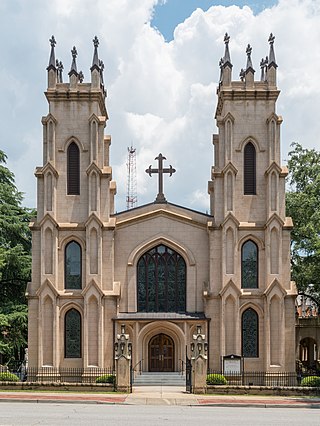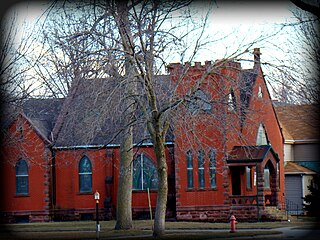
The Cathedral Basilica of Our Lady of Peace is the mother church of the Diocese of Honolulu and houses the cathedra of the Bishop of Honolulu in Honolulu, Hawaiʻi. It is located at the north end of Fort Street Mall in downtown Honolulu. Another cathedra was installed in the Co-Cathedral of Saint Theresa of the Child Jesus, also serving the diocese.

The Cathedral Church of St. Paul is the cathedral church of the Episcopal Diocese of Michigan. In 1824 its congregation formed as the first Episcopal and first Protestant church in the Michigan Territory.

Grace Episcopal Church located at 1011 North 7th Street in Sheboygan, Wisconsin, is an Anglo-Catholic parish of the Episcopal Church, part of the Diocese of Fond du Lac.

The Episcopal Diocese of Nebraska is the diocese of the Episcopal Church in the United States of America with jurisdiction over the state of Nebraska. It is in Province VI. Its cathedral, Trinity Episcopal Cathedral, is in Omaha, as are the diocese's offices. As of 2019, the diocese contains 52 congregations and 7,096 members. Average Sunday attendance is approximately 2,418 across the diocese.

The Emmanuel Episcopal Church in Rapid City, South Dakota is an historic Gothic Revival sandstone Episcopal church located at 717 Quincy Street. In 1975, Emmanuel Church was added to the National Register of Historic Places.

The Episcopal Diocese of North Dakota is the diocese of the Episcopal Church in the United States of America with jurisdiction over the state of North Dakota plus Clay County, Minnesota. It has 19 congregations in North Dakota and one in Moorhead, Minnesota. It is in Province VI and its cathedral, Gethsemane Episcopal Cathedral, is in Fargo, as are the diocesan offices.

The former St. Stephen's Episcopal Church also known as St. Stephen's Church, is an historic stone Gothic Revival-style Episcopal church building located on the southeast corner of 3rd Avenue and 5th Street in Casselton, North Dakota, United States.

The Gethsemane Evangelical Lutheran Church is a church located at 4461 Twenty-Eighth Street in Detroit, Michigan. It was designated a Michigan State Historic Site in 1980 and listed on the National Register of Historic Places in 1982. The building now houses the Motor City Missionary Baptist Church.

Trinity Episcopal Church, now known as Trinity Episcopal Cathedral, is the first Episcopal and the oldest surviving sanctuary in Columbia, South Carolina. It is a Gothic Revival church that is modeled after York Minster in York, England. It was named to the National Register of Historic Places on February 24, 1971.

Trinity Episcopal Cathedral, formerly known as Grace Cathedral, is the historic cathedral in the Diocese of Iowa. The cathedral is located on the bluff overlooking Downtown Davenport, Iowa, United States. Completed in 1873, Trinity is one of the oldest cathedrals in the Episcopal Church in the United States. It was individually listed on the National Register of Historic Places in 1974. In 1983 the cathedral was included as a contributing property in the College Square Historic District, which is also listed on the National Register.

St. Paul's Episcopal Cathedral, is located in downtown Des Moines, Iowa, United States. It is the cathedral church of the Episcopal Diocese of Iowa. The building was listed on the National Register of Historic Places as St. Paul's Episcopal Church.

Trinity Episcopal Church is a parish church in the Diocese of Iowa. The church is located in Muscatine, Iowa, United States. It was individually listed on the National Register of Historic Places in 1974. In 2006 it was included as a contributing property in the Downtown Commercial Historic District.

Trinity Memorial Episcopal Church is a former parish church in the Episcopal Diocese of Iowa. The historic building is located in Mapleton, Iowa, United States. It was listed on the National Register of Historic Places in 1990. The former church building and hall now house the Museum of American History.

St. James Basilica is a parish church in the Diocese of Fargo as well as a minor basilica located in Jamestown, North Dakota, United States. A previous church building, completed in 1882, served briefly as a cathedral in the 19th century. The present church building was listed on the National Register of Historic Places in 1982 as St. James Catholic Church, and it was elevated to a minor basilica in 1988.
Grace Episcopal Church is a historic Episcopal church building is located at 210 C Avenue, South, in Minnewaukan, Benson County, North Dakota.

Grace Episcopal Church is an historic Episcopal church building located at 405 2nd Avenue, North East, in Jamestown, Stutsman County, North Dakota. Designed in the Late Gothic Revival style of architecture by British-born Fargo architect George Hancock, it was built 1884 of local fieldstone exterior walls and a wooden roof. Early parish records contain several assertions that George Hancock modeled the church after Christ Episcopal Church which had been opened in 1881, but if he did, it was only in a very general, not specific way. Hancock's later work St. Stephen's Episcopal Church is much more closely related to Christ Church, Medway. On December 3, 1992, Grace Episcopal Church was added to the National Register of Historic Places.
Grace Episcopal Church is an historic Episcopal church building located at 152 Ramsey Street, West in Pembina, Pembina County, North Dakota. Designed in the Late Gothic Revival style of architecture by Fargo architect George Hancock, it was built in 1886. Unlike all the other churches in the Episcopal Churches of North Dakota Multiple Property Submission (MPS), it was built of brick instead of local fieldstone. The brick is yellow and was made locally by the Pembina Brick Company. The church building is one of only three extant building built of this brick. In 1937 Grace Church closed due to declining attendance and the building was sold by the Episcopal Diocese of North Dakota to the local Methodist congregation. Today it is the Pembina Pioneer Memorial United Methodist Church. On September 2, 1994, the building was added to the National Register of Historic Places as Grace Episcopal Church.

St. Mark's Pro-Cathedral is an Episcopal Church building located in Hastings, Nebraska, United States. It has been listed on the National Register of Historic Places since 1987. In 2020, it reported 247 members, average attendance of 64, and $120,307 in plate and pledge financial support.
Hugh Latimer Burleson was bishop of the Diocese of South Dakota in the Episcopal Church in the United States from 1916 to 1931.

Christ Church, also known as Christ Episcopal Church, is a Christian house of worship located on the corner of Church Street and Main Street in Newton, New Jersey. It is a parish overseen by the Episcopal Diocese of Newark, a diocese of the Episcopal Church in the United States of America. The congregation first met on 28 December 1769 and was granted a charter by New Jersey's last Royal Governor William Franklin on behalf of Britain's King George III. Christ Church is the oldest church in Newton and the third oldest parish in the Diocese of Newark.



















